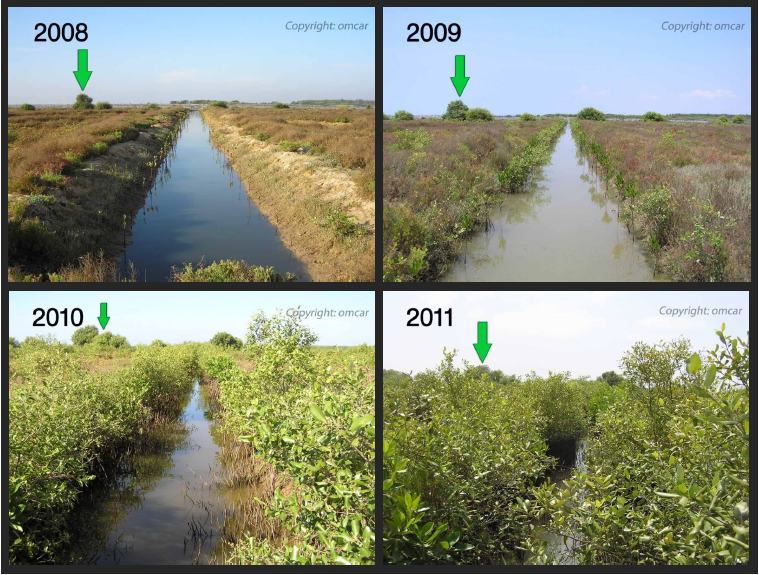
Photo sequence showing mangrove restoration at Palk Bay, India. (©OMCAR Foundation)
Ecological restoration is the process of assisting the recovery of an ecosystem that has been degraded, damaged, or destroyed.
Ecosystems are dynamic communities of plants, animals, and microorganisms interacting with their physical environment as a functional unit.
These communities can be damaged, degraded, or destroyed by human activity.
- Damage refers to an acute and obvious harmful impact upon an ecosystem such as selective logging, road building, poaching, or invasions of non-native species.
- Degradation refers to chronic human impacts resulting in the loss of biodiversity and the disruption of an ecosystem’s structure, composition, and functionality. Examples include: long-term grazing impacts, long-term over fishing or hunting pressure, and persistent invasions by non-native species.
- Destruction is the most severe level of impact, when degradation or damage removes all macroscopic life and commonly ruins the physical environment. Ecosystems are destroyed by such activities as land clearing, urbanization, coastal erosion, and mining.
Ecological restoration seeks to initiate or accelerate ecosystem recovery following damage, degradation, or destruction.
Restoration practitioners do not carry out the actual work of ecosystem recovery. Rather, they create the conditions needed for recovery so the plants, animals, and microorganisms can carry out the work of recovery themselves. Assisting recovery can be as simple as removing an invasive species or reintroducing a lost species or a lost function (like fire); or as complex as altering landforms, planting vegetation, changing the hydrology, and reintroducing wildlife.
The goal of ecological restoration is to return a degraded ecosystem to its historic trajectory, not its historic condition. The ecosystem may not necessarily recover to its former state since contemporary ecological realities, including global climate change, may cause it to develop along an altered trajectory, just as these same realities may have changed the trajectory of nearby undisturbed ecosystems. History plays an important role in restoration, but contemporary conditions must also be taken into consideration.
When is restoration complete?
Ecological restoration aims to re-establish a self-organizing ecosystem on a trajectory to reach full recovery. While restoration activities can often place a degraded ecosystem on an initial trajectory of recovery relatively quickly, full recovery of the ecosystem can take years, decades, or even hundreds of years. For example, while we can initiate a forest restoration process by planting trees, for full recovery to be achieved, the site should be a fully functioning forest with mature trees in the age-classes representative of a mature native forest. If there were 500-year-old trees in the forest that was destroyed, then the restoration should logically take hundreds of years to achieve full recovery. During that recovery period, unforeseen barriers to recovery may be encountered, or additional restoration activities may become possible at later stages of development. Thus, while individual restoration activities may be completed, in most cases the restoration process continues as the ecosystem recovers and matures.
Restoration is not a substitute for conservation.
While we can successfully restore biodiversity, structure, and function to a degraded ecosystem, ecological restoration is not a substitute for conservation, nor should the promise of restoration be used to justify destruction or unsustainable use. In reality, restoration may not succeed in re-establishing the full assemblage of native species or the full extent of the original ecosystem’s structure and function.

